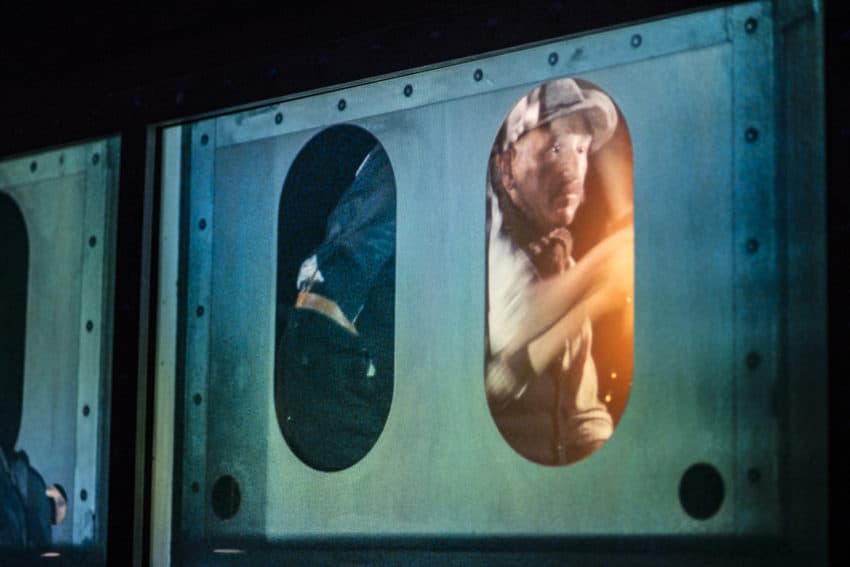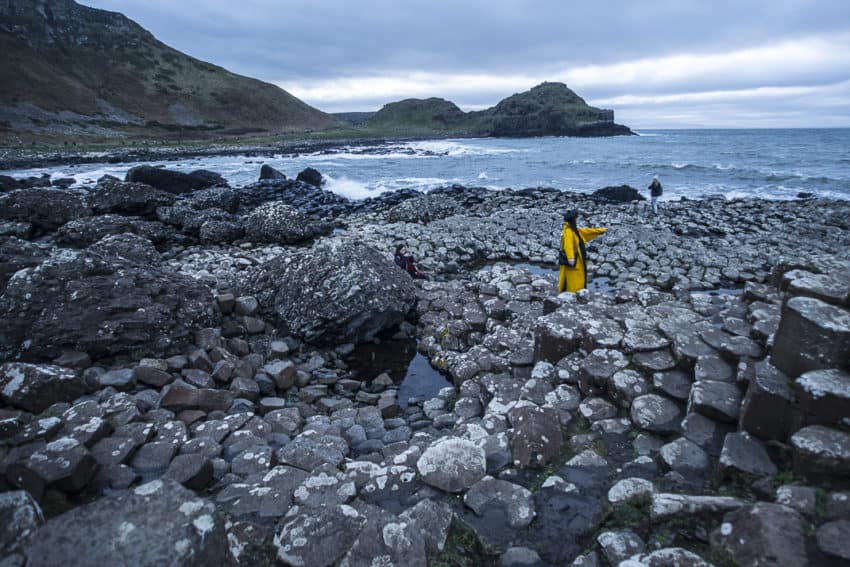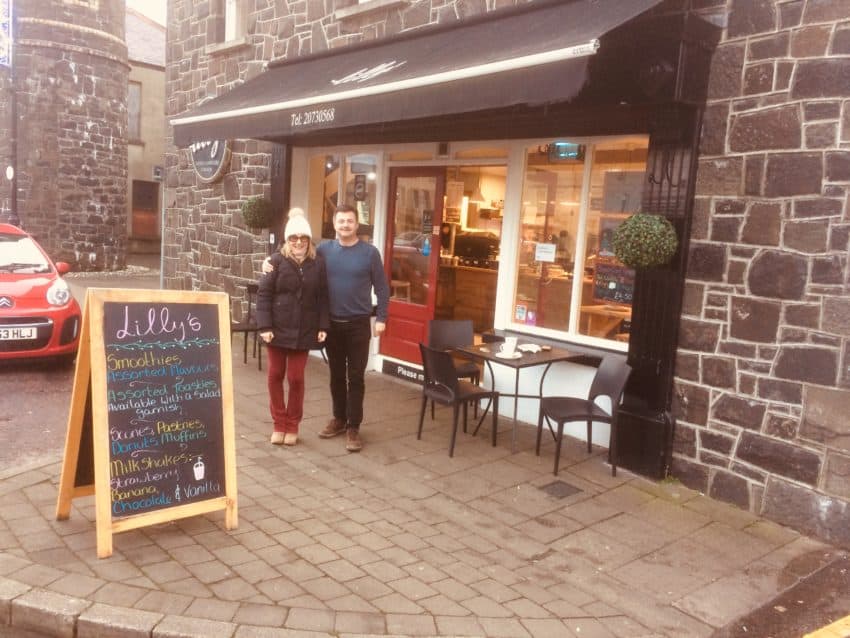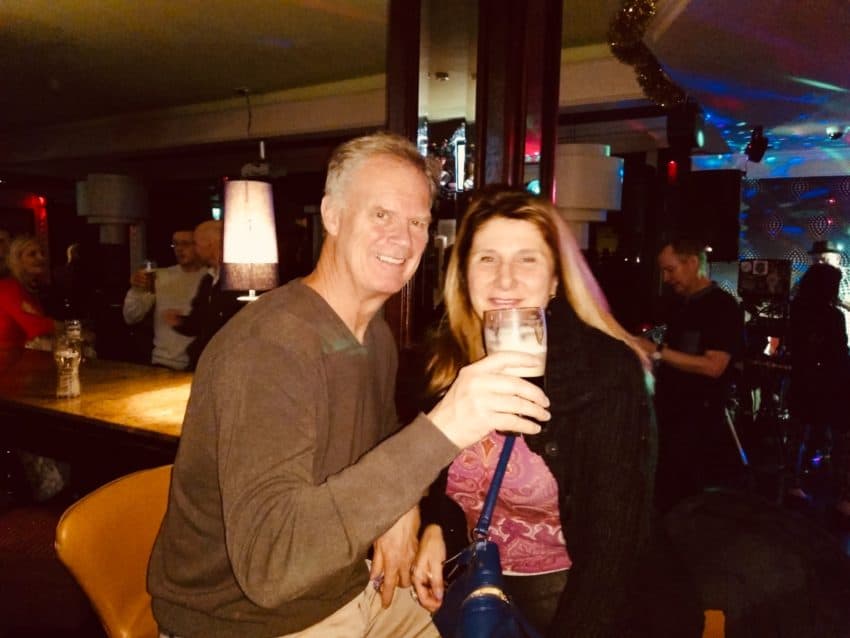Belfast emerging from the depths to become a Titanic travel destination

(Second of two parts)
BELFAST, Northern Ireland — Rivers are underrated as romantic venues. The moonlight cruise of the Seine River in Paris remains one of the most romantic hours of my life — and I was alone. The Thames with the illuminated Tower of London and Big Ben hovering over it is always a beautiful sight. Even Rome’s filthy Tiber, at night, looks like the Seine in spring.
The River Lagan in Belfast? Not so much.
Still, there we were, Marina and I, leaving Rome to ring in the new year in what for 30 years was Europe’s most violent city. We were sitting on the Lagan on a boat that shipped coal in from the Netherlands during the Troubles, Northern Ireland’s civil war from 1969-99. Cruising the Seine with Tchaikovsky on the loudspeaker it was not.
But it was close.
This boat no longer shipped coal. Instead it’s home to Holohan’s on the Barge, one of Belfast’s two Michelin-star restaurants. Built six years ago, Holohan’s made the United Kingdom’s Most Romantic Restaurant list for 2017.
Living in one of the most romantic cities in the world, Marina and I can give Holohan’s two hearts up. We sat in the corner at a small, polished-wood table, looking out at the water and the Queens Bridge and Queen Elizabeth Bridge. Bill Withers’ “Lean on Me” played over the soft loudspeaker. Locals chatted at the cozy, curved, wood, fully stocked bar.
We dined on smoked mackerel appetizers. We ate turkey and ham with sage, onion and apricot stuffing. We tried boxta, the traditional Irish potato pancake from County Mayo. It was as good as anything I’ve had in numerous trips to Great Britain — or one previous trip to Ireland. I wasn’t surprised.
After all, this is the new Belfast.
While under the surface some simmering tension remains from the Troubles (see Part I), this has become a peaceful city. It is a city that has put down its gun and picked up a pint of cold Guinness, the Guinness that tastes better on the Irish isle than any other place in the world. The battle fatigues are gone and the Brooks Brothers suits are in. Rubble and barbed wire are replaced by new hotels and renovated bars.
This is a city that is partying like its British and Irish cousins.
“It’s a world away from what it was before,” said Mark Neill, 48, a cab driver for 25 years who does tours of the Troubles spots called Black Taxi Tours (www.niblacttaxitours.com). “Kids in the city center are enjoying themselves. You can feel the positivity now. Ten years ago it was still a bit raw, but you saw the potential.”
Twenty years of peace, plus funding from the United Kingdom, has made Belfast boom. The number of overnight visitors has gone from 440,000 in 1995 to 980,000 in 2011 to 1.5 million in 2017. Six hotels opened last year bringing the total to 38 and rooms to 5,000, nearly doubling the number of 3,000 from 2006. That includes the $70 million, 23-story Grand Central hotel with an observatory tower on the top floor and the $33 million AC Hotel, the first in Belfast from the Marriott chain. The famed Muriel’s Cafe Bar is planning a $450,000-pound rooftop extension. A George Best Hotel, named for one of the greatest soccer players in history and the most famous athlete Northern Ireland ever produced, is planned to open near City Hall this year.
“If you’re a tourist and visiting here, this is one of the safest places you’ll ever be,” Neill said. “People are very friendly.”

The attractions here go beyond being able to sit in a pub without getting blown up. It’s off the beaten path. You don’t see the hordes you see in London and Dublin. I didn’t see a single American wearing a Yankees cap. Restaurants and wine bars offer upscale alternatives to the rough-and-tumble pubs that made Belfast famous. (Thai fish cakes with a Spanish Tempranillo at Harlem restaurant downtown anyone?) And, yes, indeed, the people are friendly. Locals painstakingly gave us directions. Old-timers described life during the Troubles in painful detail. Busy waiters gave us history of their restaurants.
Belfast isn’t as out of the way as you think. While you can fly into Belfast, we flew into Dublin and an Irish friend drove us the 90 minutes north. The line between Northern Ireland and the Republic of Ireland is so blurred, the border doesn’t even have a marking, let alone a checkpoint.
We lounged in style at the four-star Clayton Hotel, part of the British/Irish hotel chain, which featured a terrific spa and an outrageous, sprawling breakfast buffet that made us skip lunch a couple of days. Another huge draw for Belfast: It’s relatively cheap. For this four-star palace we paid only 351 euro (about $400) for three nights — over New Year’s Eve.

The Clayton is right in the heart of the center, four short blocks from beautiful and gargantuan City Hall, built in 1906 and featuring four towers and a 173-foot copper dome. We were also just down the street from St. George’s Market. It’s Belfast’s weekend crafts and food market and the perfect place to start or end your trip. Wandering around the stalls in an enclosed space the size of a high school gym, you’ll drop the stereotype of bland Irish cuisine. We sampled curry sauce, bought aged Westcombe cheddar cheese, salivated over the crepes and smoothies. We talked to locals who hand-made costume jewelry and painted landscapes of an Irish countryside so green the paintings look made with one color.
A two-piece band played Stealers Wheel’s “Stuck in the Middle with You.” It was a good day. It wasn’t the welcome-to-Belfast moment I expected after yearning for so many years to visit a war zone.

Belfast’s biggest draw, however, is a paradox, a perfect symbol of its city. Titanic Belfast is as modern as what Belfast has become and as eerie as what it once was. Built in 2012 for 101 million pounds ($130 million), the museum consists of a series of angular wings. It’s intended to represent ships’ prows but cynical locals think it looks more like an iceberg, an unfortunate misstep considering this is next to the shipyard where they built the Titanic.
The 130,000-square-foot museum took us from the beginning to well after the end. It starts with a look at Belfast’s boom years in the 19th century for the city’s world-leading linen industry. Huge placards and photographs took us through the history step by step, including the first involvement of Harland and Wolff, the legendary shipbuilders whose cranes, still sporting the H&W logo, remain a Belfast landmark. Then it goes from the construction to the launch to the fit-out to the maiden voyage to the sinking and to the aftermath.
You probably know that the Titanic sank April 15, 1912, killing 1,517 on board. Some things you probably know about it:
* It took 15,000 workers 26 months to build.
* Eight people died during the construction, mostly by electrocution. But one 14-year-old boy (No, child labor laws weren’t in place then.) when he fell off the two planks that held workers aloft — without safety harnesses.
* The ship carried 75,000 pounds of meat, 40,000 eggs — and 8,000 cigars.
* A first-class cabin cost 26 pounds (about $33).
* After the experimental launch on May 31, 2011, it took a year to fit out the ship. It included a Turkish bath, smoking rooms in all three classes and 16 pianos.
The museum is extraordinarily user friendly. It has nine interactive galleries, but the highlight was Marina and I stepping into what looked like a roller coaster seat. A mechanical arm took us up through a makeshift, dimly lit shipbuilding yard where we saw weirdly realistic, 3D laborers building the ship, like two sweaty men hammering some of the 3 million rivets with hand tools. The ride was hellaciously noisy, purposely made to realistically show what caused many of the laborers later to go stone deaf.
The last room is a terrific modern video of the discovery of the Titanic by Robert Ballard in 1985 who used a submarine to photograph it 2.4 miles down on the ocean floor. You hear the play-by-play commentator of what they see, from stylish dinner plates to heating mechanisms.
Marina and I like to get out into rural areas when we visit cities. The year before in Fez, Morocco, we spent New Year’s Eve day in Safou, a small town with a big medina, no tourists and a great local hole in the wall where we ate like royalty for pennies.

This time we went to Northern Ireland’s greatest natural attraction. The Giant’s Causeway is 60 miles from Belfast on Northern Ireland’s northernmost tip. You don’t need a clear day to see Scotland 25 miles to the east. I had never heard of the Giant’s Causeway. It sounded like a mall.
Our Irish friend assured me it wasn’t. Patrick O’Byrne, 53, is a Belfast native who I got to know last year while he lived in Rome working with the European Union. He drove us out of Belfast through beautiful green meadows, green farmlands, rolling green hills. It was so green, even the sheep look green. I’m from Oregon. I know green.
Northern Ireland is greener than St. Patrick after a three-day binge.
“We say Ireland is a plain picture inside a beautiful frame,” O’Byrne said.

We first stopped for lunch and found a place right out of central casting. In Bushmills, home of the famed 235-year-old whisky, we entered Lilly’s, a black-brick diner with a small menu on the wall. Dominating it is the fish ‘n chips which came out as a giant slab of deep-fried cod on a foot-long bed of French fries. It was big and greasy and oh, so good. Poor Marina may have gained back the two kilos she put on in the U.S. in August then lost in Rome.
Up a few miles the road comes to a stop at the North Atlantic Ocean. We parked in a packed parking lot and walked toward the sea. On a windy, 50-degree overcast day, the Atlantic looked cold and gray and foreboding, like you’d see in a shipwreck film. As we cleared a small hill, we saw it: 40,000 interlocking basalt columns, looking like little stone Legos, stacked on top of each other stretching for about 100 meters. Hugging the sea, some of the piles were nearly 40 feet high.
Trying to walk on them was like walking on icy sawed-off logs. I scrambled all over the place. I took little solace in knowing people have tripped along here since the Dawn of Man. The Giant’s Causeway was formed 50-60 million years ago after a volcanic eruption shot molten fluid up through chalk beds to form a lava plateau then contracted.

That’s the geological explanation.
The local fable is a giant from Irish mythology called Fionn mac Cumhaill (or Finn MacCool which sounds like an Irish rock star) took up a challenge from a Scottish giant named Benandonner. He told ol’ Fionn to build a causeway across the sea so they could meet. But when Fionn saw how big Benandonner was, his wife disguised him as a baby and hid him in a cradle. Benandonner saw the size of the baby and, figuring if that’s the size of the kid the dad must be a nightmare, ran back to Scotland and destroyed the causeway so Fionn couldn’t follow him.
The tale also lends credence to the Irish’s feeling of superiority over the Scots as Benandonner was, obviously, a complete and utter moron.
It’s a sobering story, one of the few sobering moments you could have in Belfast if you so choose. That’s one reason I chose Belfast for New Year’s Eve. I’ve never been there, what better place to spend New Year’s Eve than Belfast and I have a girlfriend who’s never been drunk.

She and I took different paths to midnight. She shopped and rested while I prowled the old Protestant stronghold of Shankill Road doing interviews for my Part I blog on the Troubles. I started interviewing at 2:30 p.m. which, in Belfast, means I was bought a Guinness before I pulled out my pen. By the time I reached the O’Byrne family at 6, I already had five pints and thoroughly conflicted ideas on who the bad guys were in this conflict.
But I know who the good guys are now. They’re the Belfastians. The O’Byrnes met me at the Crown, Belfast’s most famous pub established in 1849. It’s not only a symbol of great victorian architecture but also of the Protestant-Catholic conundrum over the centuries. Story has it that Patrick Flanagan, the Catholic owner who refurbished it in 1885, argued with his Protestant wife what to name it. She won and it was named the Crown to honor the British monarchy. Flanagan, however, got the last laugh. He put the crown in mosaics in the entrance floor so every customer would tread their feet on it.
After a couple more rounds with an Irish family that never stopped laughing, I poured myself into Home Restaurant, where I met Marina, sober as Mother Teresa. The Home is one of the many all-natural farm-to-table restaurants that have popped up in Belfast the last 10 years. Built in 2011 near City Hall, it specializes in local produce and my herb-roasted chicken was a great chaser for a belly full of Guinness.

Later, surprisingly, Belfast was relatively tame on New Year’s Eve. The O’Byrnes continued the local tradition of celebrating at home while we went across the alley from the Crown to Brennans’. It has transformed into a shiny two-story pub where the Guinness is cold and cheap and flowed all night.
So did we. Marina said later I actually danced. I told her I’d need video proof. But I don’t need proof that I loved the rest of Belfast.
Like the city, I welcomed 2019 in peace.


January 9, 2019 @ 4:53 pm
I’m a sucker for a good “comeback “ story, and that’s a good one-thanks, and Happy New Year to you and Saint Marina!
January 10, 2019 @ 12:35 am
Thanks. Did we work together once?
January 10, 2019 @ 10:20 am
Ha! No, although I’ve been known to enjoy my fair share of pints here in the Chicago area, I’m not in the line of work to be able to get away with “ I was working on a story down at the local pub”. Marina just seems to be as understanding as my wife of 34 years, who also has earned sainthood!
January 11, 2019 @ 1:36 am
Whew! I worked with a Mike Moore in my first job and he was the biggest asshole I met in this business. I didn’t think he’d surface after 40 years and give me a nice compliment. Yeah, researching in a pub isn’t bad. It just won’t pay the bills. That’s what retirement is for.
January 10, 2019 @ 10:51 am
” Eight people died during the construction, mostly by execution.” ??Life sure was hard in the shipyard then! I missed this little item when I was there. But seriously, Belfast is a wonderful city, with lots of scenery around, especially on the north coast coming back from the Giants causeway back to Belfast.
Happy New Year to you and Marina and lots more travelling.
January 11, 2019 @ 1:34 am
Thanks, Jeff. We need to go back. Lots of pubs we missed. And I want to see hurling.